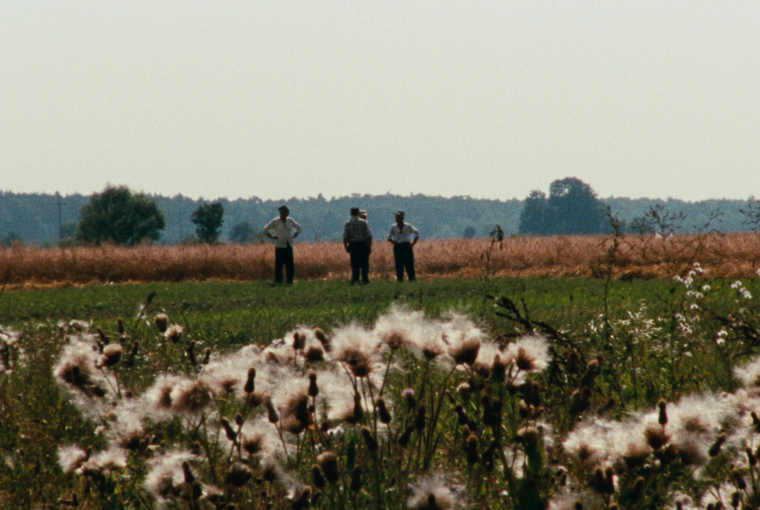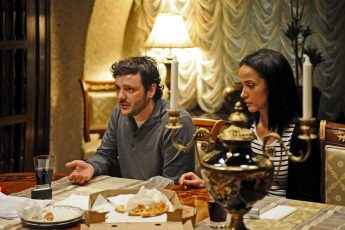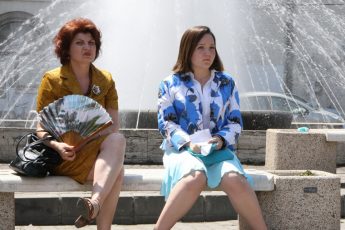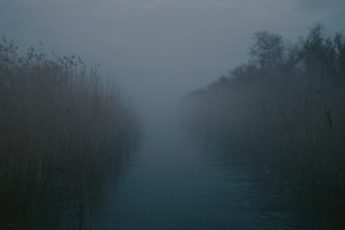Summertime Soundscapes
Anka and Wilhelm Sasnal’s It Looks Pretty from a Distance (Z daleka widok jest piekny, 2011)
Vol. 29 (May 2013) by Colette de Castro
There’s nothing pretty about the first feature-film by husband-and-wife filmmakers Anka and Wilhelm Sasnal, It looks pretty from a distance.
Pawel and his girlfriend live in separate houses in an isolated village. They decide to help his mother who seems to be suffering from dementia, and their motivation is perhaps the shame of having a parent who is incontinent rather than any filial kindliness. Her behavior is bizarre enough to upset the neighbors. And if people in general draw back from the sick, the mentally ill are often treated with fear and disgust. As Pawel Sala said “in Poland, we don’t speak about psychological troubles…”
Unlike the rest of the family however, human kindness does trump social stigmata for this young couple who finds an institution to care for his mother. However, another layer of prejudice is revealed when the girlfriend finds the house empty and the redneck neighbors later pillage and burn it down. It’s unclear whether the prejudice comes from antisemitism, a harsh judgment on the abandonment of a mother-figure in an asylum, or just boredom and greed brought on by a long, poor summer in an isolated Polish village.
Villagers who have been cooped up inside all winter turn their thoughts to petty cruelty when confronted with the mundane everyday. One scorching-hot day, a teenager winds around the rope which attaches a mangy dog to a concrete boulder until it can hardly walk two steps, then throws away it’s drinking water.
Most of the action centers around the small house where Pawel and his family live, which is perched in a field in the middle of nowhere. Endless sky is the only witness to the goings on in this desolate place, where the train tracks serve as the main attraction, with a train whizzing past every few hours. We are quickly introduced to the villagers whose lives are as monotonous as their bodies are filthy… The only person who seems to do any cleaning is Dziewczyna (Agnieszka Podsiadlik), whose name means girl or girlfriend in Polish.
There are parallels with An Episode in the Life of an Iron Picker by Danis Tanović (2013), not only in the documentary-like realism of the film, but also in the use of a car as a metaphor for everyday life. These vehicles, which are savagely cut up and picked apart for scrap-metal and parts, are literally going nowhere. Destruction and creation are treated with the same detached determination, the difficulty of everyday life in this superficially Arcadian village slowly reveals a hidden cruelty. When the villagers come to tear her boyfriend’s house apart, the girlfriend stoically contributes to the carnage, just as she was meticulously cleaning the house and it’s contents in the previous scenes. She is pictured deliberately throwing objects into the growing fire.
A film that has been stripped nearly bare of dialogue, jointly directed by a visual artist (Wilhelm Sansal is a well-known painter of matt portraits and landscapes). Many aspects of this film, even its title, suggest – if not implore – that we look. The cinematography dwells on this house, things that appear pretty from afar but up close they are riddled with maggots, flies and all sorts of crawling insects that come out to play after a long winter, reminding us, as they do every year, of the downside of that lovely season.
What is surprising however, is the subtle importance of the film’s soundscape, which perhaps reveals even more than the landscape. Every scene has a set of sounds that fit in perfectly with the atmosphere. In the village shop, where the female character chats with her friend at the counter, the refrigerator hums loudly over their conversation like psychedelic background music. Every outside scene is accompanied by ‘nature sounds’: birdsong, cows mooing or footsteps crunching. The film is set in summer, which allows for a whole set of rural sound effects. The soundscape is an aural feast which signals these busy aspects of the summer months. There is a strong feeling of reawakening after a sleepy winter, a time when decisions have to be made. Settling old grievances, clearing out unwanted old rubbish…
At first we may be inclined to think that this is just the result of an amateur grasp of cinema sound, but as the film continues, the soundscape becomes more and more rich, and the realization comes that it is very much a product of careful decisions. A key is the scene where Pawel’s mother stands at the open window of the place she has been taken to (an asylum?) and screams, again and again.
This wail is singularly disturbing. It is a dull, obtusely awful and unfeeling scream. Far more true to reality than the artificial Wilhelm, a scream which has become a gimmick in Hollywood productions; this careful build-up of sounds is therefore declared to be key to the film, it subtly opens up the viewers auditory sense to prepare them for the scream which will penetrate their experience. A scream, unlike an image, cannot be easily avoided while watching a film: you cannot just close your eyes to a scream, and physically blocking one’s ears would seem over-dramatic and perhaps child-like. The psychological impact of such a message is therefore much deeper than the image, which has become banal through overuse.
The scream is even more pertinent because it reveals a deeper subject within the film: the Polish treatment of Jewish people during the second world war. Anka Sasnal was influenced by the historical study Neighbors by J. T. Gross, which in turn is based on the 1988 series of documentaries by another Polish filmmaker Agnieszka Arnold; this book reveals the sometimes shocking participation of the Poles in the persecution of Jews during WWII, a participation which has long been denied or ignored. Other recent Polish films such as Sekret(2013) by Przemysław Wojcieszek also deal with this prickly subject.
The scream doesn’t come at the end, but it is pivotal. The film is built around this event, which bears the anguished message: “I DON’T LIKE IT HERE”. Here, of course, extends far beyond the four walls of the asylum, its surroundings, or even the isolated Polish village. It is the scream of a painter who cannot express with images alone, or a script-writer who cannot express with words alone, the history of a land where a harsh winter and a long summer give birth to cruelty which can no longer be ignored.




Leave a Comment